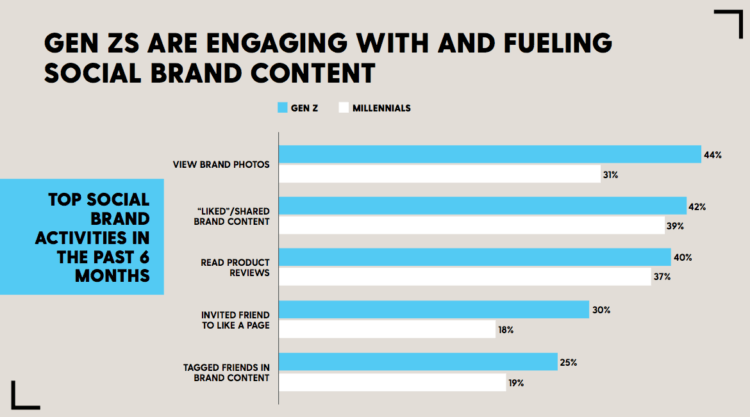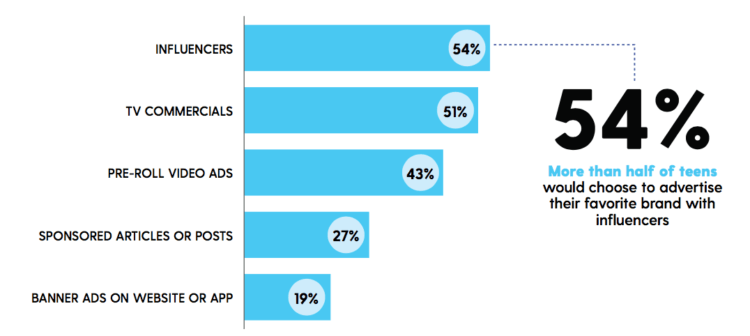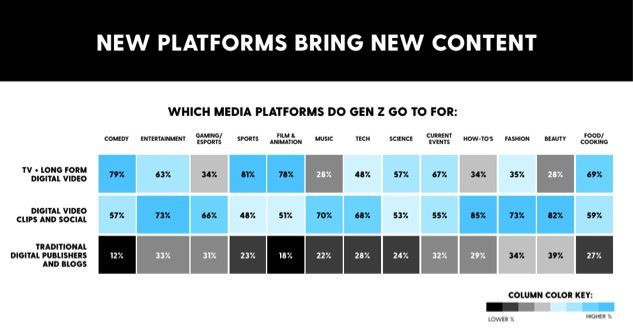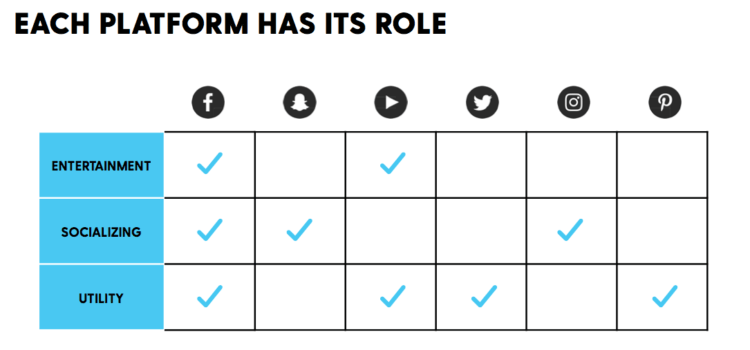Generation Z is the demographic cohort after the Millennials, which is sometimes called Generation Y. There are no precise dates for when the Gen Z cohort starts or ends, which explains why two recent studies use different definitions. But, no matter how you define it, Generation Z can’t live without YouTube.
Generation Z: OK With Branded Content
One of the studies was conducted by Defy Media for Adweek. They surveyed a group of 1,452 teens ages 13-20 about what they think about social media platforms, digital video, and the new breed of online celebrity. This survey found that YouTube is a regular part of their media diet, with 95% turning to it. The next most popular platforms are Instagram (69%), Facebook (67%), Snapchat (67%), and Twitter (52%). These teenagers were also asked, “Which one could you not live without?” And 50% said YouTube, 15% said Snapchat, 9% said Instagram, 9% said Facebook, and 6% said Twitter.
The survey also found that teens trust social stars as much as (and sometimes more than) “mainstream” celebrities (like actors, singers, or reality stars). These teenagers were asked, “Which kinds of celebrities would you trust for advice about buying” a variety of items. For tech gadgets, 70% said online celebrities, while 21% said mainstream celebrities. For beauty products, 48% said online celebrities and 44% said mainstream celebrities. However, for clothes or accessories, 43% said mainstream celebrities, and 41% said online celebrities.
The majority of Gen Zers are cool with almost any type of celebrity branded content, but they prefer when it’s disclosed. (Their parents and teachers should be proud.) In fact, 79% said they are always or sometimes okay when a celeb talks about why they like or use a brand. And 62% said its totally or somewhat okay when a celeb talks about their political views. (And you thought that only late-night comedians had discovered that politics was cool.)

For me, the most fascinating findings were about the different ways that Generation Z uses different platforms. For keeping in touch with friends, 35% use Snapchat, 28% use Facebook, and 18% use Instagram. For catching up on the news, 23% use Facebook, 23% use YouTube, and 14% use Twitter. (Gen Z keeps up with the news! Who knew?) For a good laugh, 51% use YouTube, 11% use Instagram, and 9% use Snapchat.
For shopping recommendations, 24% use YouTube, 17% use Instagram, and 16% use Facebook. And for how-to info, 66% use YouTube, 9% use Pinterest, and 6% use Facebook or Google+ (a tie). (Hey, Gen Z has grown up in an entirely digital world, so they have a very sophisticated understanding of the best uses of more than half a dozen social media platforms. Maybe it’s just old Baby Boomers who assume that one size fits all.)
GenZ: Social Video First
But wait, there’s more! A second study by Leflein Associates for Fullscreen surveyed over 1,200 participants between 13 and 17 years old (Generation Z) and between 18 to 34 years old (Millennials). Yep, they used a different definition of Generation Z. But, they also found that Gen Z actually wants your branded content, social first is preferred, and influencers are still celebrities.
Now, younger audiences are an important target for many brands, but not all brands recognize that there are actually two very different generations (depending on your definition) within that broad umbrella – in this case, Gen Z (13-17) and Millennials (18-34) – with two very different sets of social media habits. Brands should not assume they can target both groups in the same way.
Millennials are now relatively “old school,” with a higher preference for “traditional” platforms (including “traditional digital” platforms) than their Gen Z counterparts. Gen Zers are shifting away from text-based online content in particular, in favor of streaming content – especially video. (My oldest son is 34. He teaches history at a high school in Boston, and he’s invited me to talk to a couple of his classes about the Vietnam War – which heated up back in the “old days” when I was in high school about 50 years ago. So, I’ve met Gen Z face-to-face and know that they are different from Millennials.)
Now, when most marketers talk about how brands can best reach and engage with “young people,” they usually mean Millennials – because most marketers are over 35 years old. I know this is changing, but at least this used to be true. As it turns out, Gen Z is even more receptive to engaging with brands through social channels than Millennials are. In fact, they’re adept at fueling brand conversations by spreading the word throughout their social circles.


Like the Adweek study, the Fullscreen study found that influencers play a significant role in defining what youth audiences like, view, and buy.
But the Fullscreen study dug deeper and found that Gen Z prefers to watch, rather than read. They view digital video and short form clips almost six times as much as they read traditional digital publishers/blogs. It’s critical to note the dramatic rise in short-form video, a new format that has emerged and evolved alongside social platforms. While longer-form formats are still preferred for traditional entertainment genres like sports, comedy, and film, short-form plays a pivotal role for beauty, fashion, and how-to’s – and even general entertainment.

And like the Adweek study, the Fullscreen study found that one size does not fit all when it comes to social platforms. Despite its reputation as a social home for older folks, Facebook still dominates for entertainment, socializing and utility for Gen Z. For socializing, Facebook, Snapchat, and Instagram take center stage. And for utility, more task-specific platforms like Twitter and Pinterest come into play.

So, what’s the net-net? If you’re an older video marketer – either a member of Generation X or even a Baby Boomer like me – then what are the key takeaways? Well, here are a few bullet points, which Gen X marketers seem to prefer:
- Follow Gen Z to where they lean in and live their lives.
- Don’t be afraid to be a “social-first” marketer.
- Choose and use your social platforms wisely.
- Find your audience’s passion. It may not be your brand.
- Work with influencers to build credibility and find common ground with Gen Z.
- Create compelling, share-worthy content — just like a true friend would.
Takeaways for Baby Boomers
Or, if you’re a Baby Boomer who prefers narratives, then here are the top three takeaways that you can take to the bank.
First, it’s important to recognize that Gen Z is not only the first generation born into a post-Google and social media world, but also the most diverse generation yet. And as Pete Stein, the General Manager of Fullscreen, has observed, “Their continued inclination towards social content on their mobile phones – first seen in Millennials – is changing the way that content is consumed, shared, and even created. Growing up in a completely digital world, they expect to have direct access to friends, celebrities and brands – and they expect all three to interact and share content in a way that’s relevant to their own personal interests and passions.”
Second, it’s also important to understand that we aren’t living in an era of increased media fragmentation – because fragmentation assumes that the same audience is being broken into small pieces. We’re living in an era of increased media segmentation, and brands are discovering that the best way to build deeper customer connections is to create content that is tailored to different segments. As Maude Standish, the Vice President of Programming Strategy at Fullscreen, has noted, “This is particularly true when marketing to Gen Z, who grew up with the internet and are not only demanding that all brands entertain them, but also that entertainment shifts to behave like a friend – it’s also why influencers are so effective in selling to this generation.”
And third, that old notion that one size fits all wasn’t true even in the Mad Men era. Although most marketers back in the old days used the 3 television networks to reach roughly the same general interest audience, some pioneers used scores of special interest magazines like Car and Driver to reach targeted segments like auto enthusiasts. I know because my dad was the director of marketing at Oldsmobile back in the 1980s when I started working for Ziff-Davis, which had once published Car and Driver magazine. So, that’s one of the untold stories that I’d like to share with younger marketers who are trying to reach newer generations. Get it? Got it? Good.